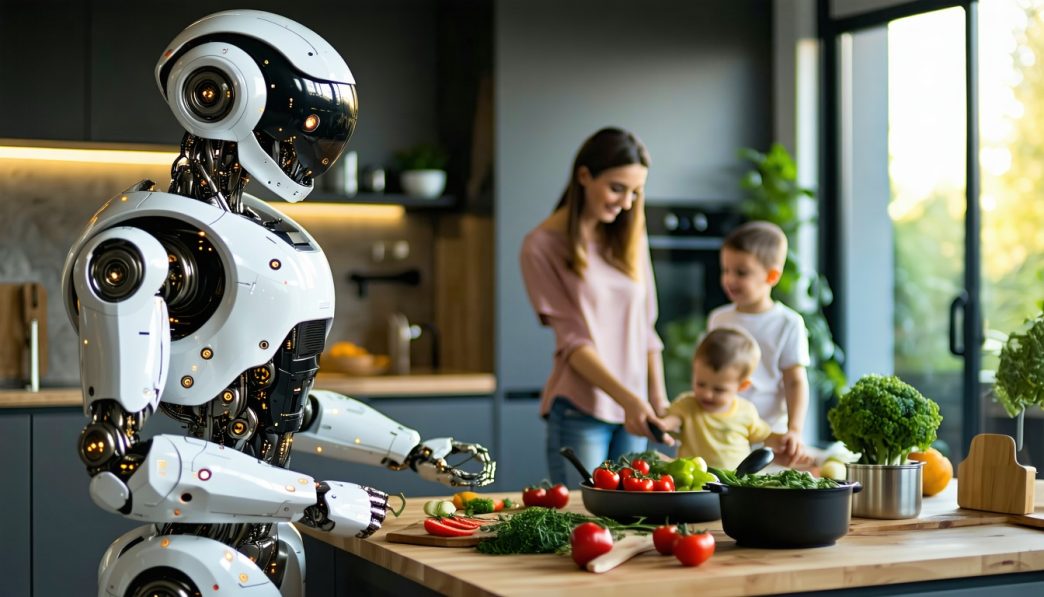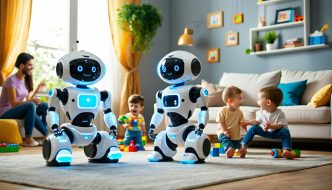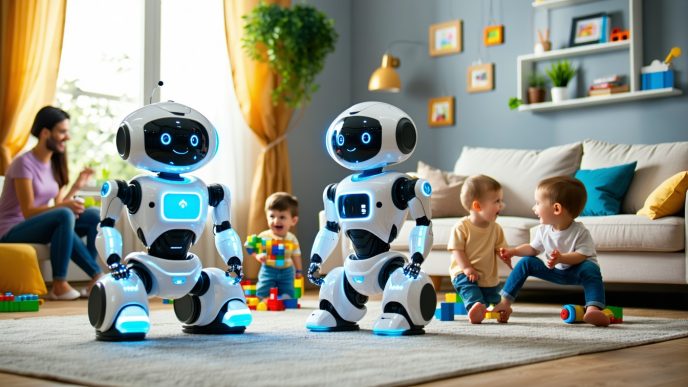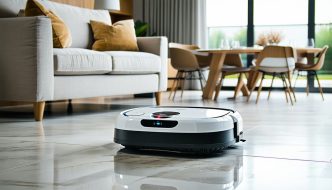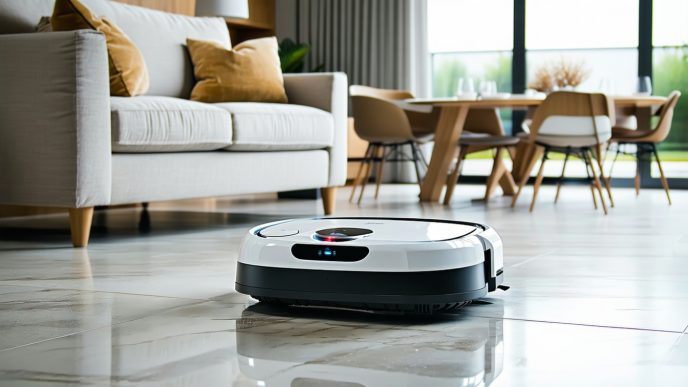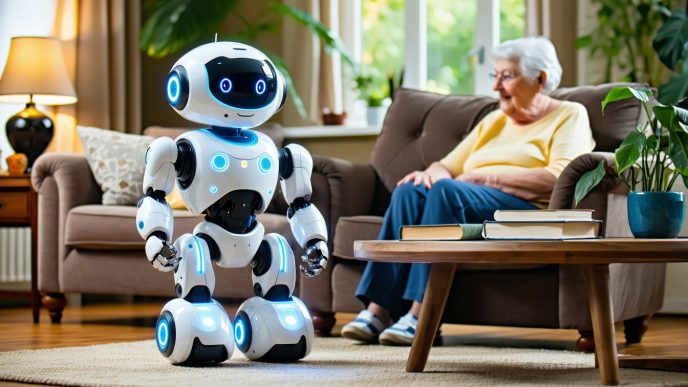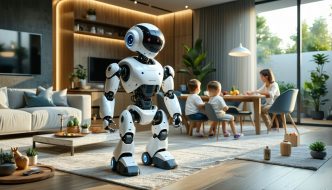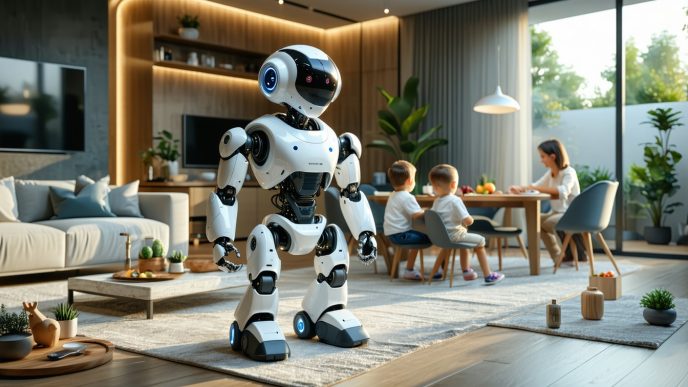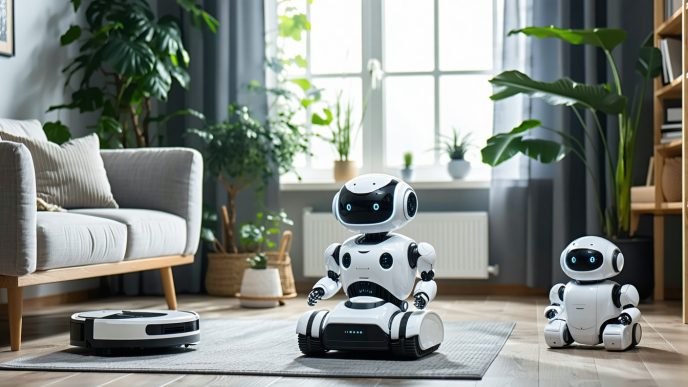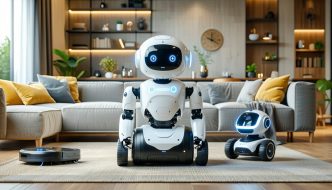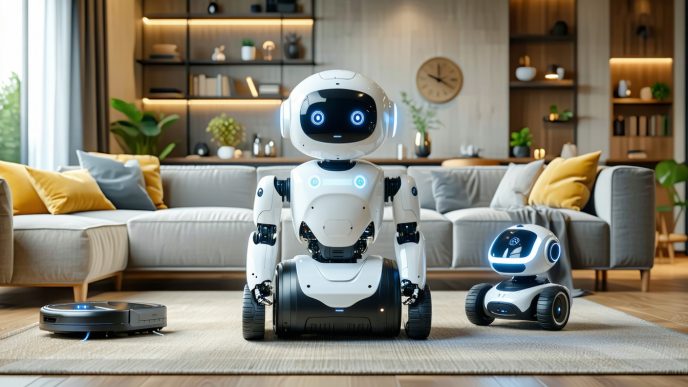The Rise of Humanoid Robots
Humanoid robots have emerged as an innovative solution in home assistance, reflecting significant advancements in technology. As households look for ways to simplify daily chores and enhance quality of life, these robots have seen a surge in interest.
Evolution of Robotics in Home Assistance
The development of robotics has progressed from simple mechanized tools to sophisticated humanoid robots capable of performing a variety of tasks. Initially, home assistance technology was limited to robotic vacuum cleaners and basic appliances. Over time, advancements in artificial intelligence (AI) and machine learning have led to the creation of robots that can interact with family members, recognize voices, and navigate complex environments.
Humanoid robots now incorporate advanced features such as:
| Feature | Description |
|---|---|
| Artificial Intelligence | Enables learning and adaptation to user preferences |
| Voice Recognition | Allows for communication and command execution |
| Mobility | Facilitates movement around the house with ease |
These enhancements contribute to the increasing functionality of humanoid robots, making them more appealing to modern households.
Benefits of Having a Humanoid Robot at Home
Humanoid robots offer numerous advantages for families and individuals looking to improve their daily lives. Some key benefits include:
| Benefit | Description |
|---|---|
| Increased Efficiency | Humanoid robots can perform tasks like cleaning and assistance, freeing up time for family members. |
| Enhanced Security | Robots can monitor homes while the occupants are away, providing peace of mind. |
| Companionship | These robots can engage in interaction, offering companionship, especially to seniors or those living alone. |
The integration of humanoid robots in daily life not only promotes convenience but can also enhance overall well-being by allowing individuals to spend more quality time with family and friends. For those interested in comparing different types of robots, exploring the best overall robots for home use can provide valuable insights into options that improve home life.
Factors to Consider
When choosing the best humanoid robots for home assistance, several important factors should be taken into account. Understanding these elements can help homeowners, renters, families, and early adopters make informed decisions regarding their investments in robotic technology.
User-Friendliness
User-friendliness is a key factor when selecting a humanoid robot. A robot that is easy to operate decreases the learning curve for users and allows for seamless integration into daily routines. Features that enhance user-friendliness include:
- Intuitive interfaces
- Simple setup procedures
- Comprehensive user manuals or guides
To better illustrate the importance of this factor, here is a table displaying some user-friendly attributes:
| Feature | Description |
|---|---|
| Touchscreen Interface | Provides clear and easy navigation |
| Voice Commands | Allows hands-free operation |
| App Connectivity | Enables control via smartphone or tablet |
Maintenance and Support
Maintenance and support services play a significant role in ensuring the longevity and functionality of humanoid robots. Prospective users should consider:
- Warranty and repair options
- Availability of customer support
- Recommendations for regular maintenance routines
Here is a comparative table that indicates common forms of maintenance and support:
| Support Type | Description |
|---|---|
| Warranty Period | Length of coverage for repairs or replacements |
| Customer Service Availability | Hours and methods of contact (phone, email, chat) |
| Maintenance Frequency | Recommended intervals for upkeep |
Cost-Effectiveness
Cost-effectiveness is an essential consideration when evaluating humanoid robots for home assistance. Users must assess not only the initial purchase price but also the value they will receive over time. Elements contributing to cost-effectiveness include:
- Energy efficiency
- Overall durability
- Potential savings from time or resource management
The following table highlights factors contributing to cost-effectiveness:
| Factor | Description |
|---|---|
| Energy Consumption | Amount of electricity used during operation |
| Lifespan | Expected duration of the robot’s functionality |
| Maintenance Costs | Estimated costs for upkeep over time |
By evaluating user-friendliness, maintenance and support, and cost-effectiveness, individuals can better determine the best humanoid robots for their specific needs. These factors combine to create a more reliable and valuable addition to a household, enhancing the daily lives of users. For more insights, check out our article on best overall robots for home use.
Notable Features of Humanoid Robots
Humanoid robots designed for home assistance are equipped with various features that enhance their functionality and improve user experience. Three of the most notable features include voice recognition, mobility and navigation, and interaction capabilities. Understanding these features helps homeowners make informed choices when considering the best humanoid robots for home assistance.
Voice Recognition
Voice recognition technology allows humanoid robots to understand and respond to verbal commands. This feature enhances usability for a wide range of users, making it easier to interact with the robot without manual controls. Advanced voice recognition systems can differentiate between voices, enabling personalized responses for various family members.
| Feature | Description |
|---|---|
| Recognition Accuracy | Typically over 90% for clear commands |
| Supported Languages | Often multilingual, with options for localization |
| Custom Commands | Ability to program specific tasks based on user preferences |
Mobility and Navigation
Mobility and navigation are critical for humanoid robots, especially when moving around a home filled with furniture and other obstacles. Many models feature sophisticated sensors and technology that allow them to intelligently map their surroundings and navigate seamlessly.
| Feature | Description |
|---|---|
| Sensor Types | Lidar, cameras, ultrasonic sensors |
| Navigation Patterns | Autonomous movement or remote control options |
| Obstacle Avoidance | Capability to detect and maneuver around obstacles in real-time |
This capability enables robots to perform tasks like cleaning on their own. For example, certain models are designed for home maintenance and can coordinate their movements to avoid collision with furniture.
Interaction Capabilities
Interaction capabilities define a robot’s ability to engage with users effectively. This includes recognizing emotions, responding to body language, and maintaining conversations.
| Feature | Description |
|---|---|
| Emotional Recognition | Ability to identify basic emotions through voice and visuals |
| Conversational Skills | Engaging in simple dialogues and answering questions |
| Compatibility with Smart Devices | Integrating with home automation systems for improved interaction |
Good interaction capabilities allow robots to serve as companion robots for families, enhancing the sense of connection and support in the household.
By prioritizing features such as voice recognition, mobility and navigation, and interaction capabilities, homeowners can choose humanoid robots that meet their needs and improve daily life. These elements are essential when evaluating options, ensuring a reliable and integrated approach to home assistance. For other considerations in selecting the right robot, more information can be found by visiting our article on the best overall robots for home use.
Humanoid Robots for Specific Tasks
Humanoid robots are engineered to assist with various household tasks, enhancing daily life for homeowners and renters alike. Their versatility makes them a valuable addition to modern households. This section will explore how these robots can excel in cleaning, assisting with daily activities, and enhancing security.
Cleaning and Maintaining Spaces
Cleaning tasks are one of the primary functions of humanoid robots. These robots can vacate floors, mop surfaces, and even clean windows, taking a considerable burden off the shoulders of family members. Many humanoid cleaning robots are equipped with advanced sensors and mapping technology, allowing them to navigate around furniture and obstacles effectively.
| Feature | Description |
|---|---|
| Sensors | Detect obstacles and map environments |
| Cleaning Modes | Multiple modes such as deep clean, spot clean, and scheduled cleaning |
| Battery Life | Typically ranges from 60 to 120 minutes of use per charge |
For homeowners interested in robotic solutions for cleaning, refer to our article on best cleaning robots for homes for more functionality insights.
Assisting with Daily Tasks
Humanoid robots excel at assisting with daily tasks, such as meal preparation, grocery shopping, and even providing reminders for medications. Their advanced interaction capabilities allow them to act on voice commands or touch interfaces, making them user-friendly for all family members.
| Task | Robot Capability |
|---|---|
| Meal Prep | Can chop ingredients and follow recipes |
| Grocery Management | Can create shopping lists and send them via an app |
| Reminders | Provides notifications for important tasks and appointments |
Families looking for more detailed options will find valuable suggestions in our article on best companion robots for families.
Enhancing Security
Security is a growing concern for many households, which is where humanoid robots can play a vital role. Equipped with cameras, motion detectors, and alert systems, these robots can monitor household environments and notify homeowners of any suspicious activities. They can also serve as a deterrent against potential intruders.
| Security Feature | Description |
|---|---|
| Surveillance Cameras | Provides real-time video feeds and alerts |
| Motion Detection | Notifies homeowners of movements in designated areas |
| Remote Access | Allows homeowners to monitor their property from anywhere via smartphone |
For those considering security solutions, insights into suitable robots can be found in our article on best robots for seniors at home.
Humanoid robots are paving the way for a new level of efficiency in household management. From cleaning to security, their features contribute significantly to enhancing daily routines, making them a wise investment for any home.
Integration in Smart Homes
As homeowners increasingly adopt smart technologies, the integration of humanoid robots into smart home systems becomes essential. These robots can enhance daily living by automating various tasks if they are compatible with existing home systems and provide convenient connectivity options.
Compatibility with Home Systems
For humanoid robots to function effectively, they must integrate seamlessly with the homeowner’s existing systems, including lighting, heating, and security devices. Many modern humanoid robots are designed to work with popular smart home platforms, ensuring that users can control their robots alongside other smart devices.
When considering compatibility, homeowners should evaluate the following features:
| Compatibility Feature | Description |
|---|---|
| Smart Home Platform Integration | Ability to connect with systems like Amazon Alexa or Google Home. |
| Device Compatibility | Works with various smart devices such as lights, cameras, and thermostats. |
| App Control | Accessible via mobile applications for real-time control and monitoring. |
Connectivity and Control Options
Effective connectivity is crucial for enabling communication between humanoid robots and other smart home devices. Many robots utilize Wi-Fi, Bluetooth, or Zigbee technology to establish connections. The choice of connectivity affects how easily homeowners can control and monitor their robots.
Key control options include:
| Control Method | Description |
|---|---|
| Smartphone App | Allows users to operate the robot remotely using their mobile devices. |
| Voice Commands | Enables control through voice activation via smart assistants. |
| Remote Control | Some robots come with dedicated remote controls for direct interaction. |
Understanding these aspects of integration can help homeowners locate the best humanoid robots for home assistance. The right features and connectivity options enhance functionality while making robots more practical for everyday life. For further recommendations on robot types suited for specific needs, explore our articles on best cleaning robots for homes, best companion robots for families, and best robots for seniors at home.
Future of Humanoid Robotics
The realm of humanoid robotics is experiencing rapid advancements, particularly in the area of home assistance. As technology evolves, so do the capabilities of these robots, leading to more innovative and practical solutions for daily life.
Innovations in Home Assistance
Recent innovations in humanoid robots focus on enhancing user experience and expanding functionality. Some noteworthy advancements include:
| Feature | Description |
|---|---|
| Advanced AI | Robots are now being equipped with more sophisticated AI, enabling them to learn from interactions and adapt to individual household needs. |
| Enhanced Mobility | Improvements in mobility allow robots to navigate complex home environments, such as stairs and tight spaces. |
| Multilingual Voice Recognition | Many humanoid robots are capable of understanding and responding in multiple languages, making them accessible to a wider range of users. |
| Integrated Smart Home Capabilities | These robots can connect with various smart home devices, enabling seamless control over lighting, thermostats, and security systems. |
These innovations aim to make humanoid robots not only helpful but also seamlessly integrated into the fabric of home life. For more insights on advanced robotic features, check our article on best overall robots for home use.
Predictions for Household Robots
The future of household robots appears promising. Experts forecast several trends that could shape the evolution of humanoid robotics in domestic settings:
| Prediction | Description |
|---|---|
| Increased Autonomy | Future robots are expected to operate more independently, managing chores and responsibilities with minimal human intervention. |
| More Personalized Assistance | Humanoid robots will likely provide tailored assistance based on user preferences, improving the personalization of tasks. |
| Enhanced Emotional Intelligence | Robots may develop better emotional recognition, enabling them to respond appropriately to human emotions, particularly beneficial in family settings. |
| Broader Application Range | Innovations could lead to robots being utilized for a variety of tasks beyond cleaning and maintenance, such as companionship and healthcare support. |
Considering these developing trends, homeowners and families can anticipate a more integrated and valuable role for humanoid robots in their daily lives. For families, it may be beneficial to explore the options highlighted in our articles on best companion robots for families and best robots for seniors at home.
As the industry continues to evolve, it is crucial for potential users to stay informed about the advancements in humanoid robotics to make educated choices that enhance life at home.


